The Apple iPad 2 Review
by Brian Klug, Anand Lal Shimpi & Vivek Gowri on March 19, 2011 8:01 PM ESTThe iPad 2
We've already gone over the iPad 2's design in our preview so I won't spend a ton of time here. The first iPad was a pain to hold in your hand, the iPad 2 largely addresses that problem. The device is similarly sized to its predecessor but Apple removed significant volume by tapering the edges of the iPad 2. The tablet is thus more comfortable to hold, lighter and is significantly thinner than its predecessor. Apple likes to point out that the iPad 2 is now thinner than even the iPhone 4.
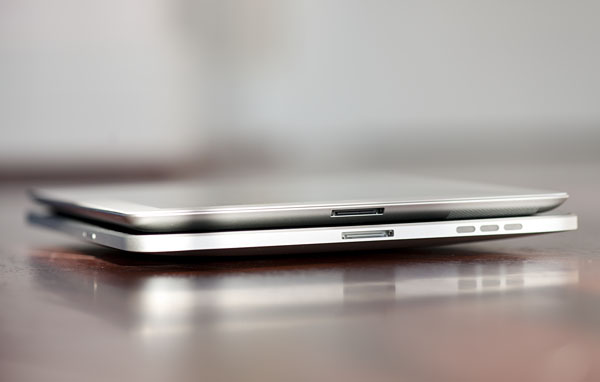
Apple iPad 2 (top), Apple iPad (bottom)
The Xoom to me was more pleasant to hold that the original iPad, however the iPad 2 takes the crown back from Motorola. I believe we'll see second generation Android tablets that rival the iPad 2's thickness but for now you have to keep in mind that we're comparing a second generation iOS tablet to first generation Android tablets. With smartphone internals and virtually nonexistent cooling requirements, building a thin tablet isn't an impossible task.
The front of the iPad 2 is pretty much unchanged from the original, with the exception of the new VGA front facing camera (720p rear camera). As we'll get to shortly, beneath the front of the iPad 2 are a number of magnets for use with Apple's new smart covers. The front bezel of the iPad 2 is available in both white and black. Surprisingly all of the AnandTech editors who contributed to this review opted for the white and all of us seemed to actually be pretty happy with the choice.
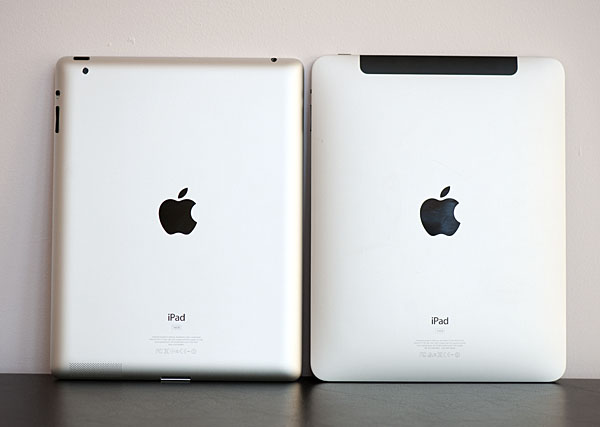
Apple iPad 2 (left), Apple iPad (right)
Flip the iPad 2 around and the back is a very familiar aluminum. Unfortunately with no protection back here you'll often find yourself laying the iPad 2 face down on a smart cover when it's not in use. Even on a clean desk I could hear tons of little particles grinding up against the aluminum. So far the iPad 2 has been pretty resilient, implying that it's made of a harder aluminum than what Apple uses in the MacBook Pro line. That being said, I still worry about scratching the back of the device. Apple makes beautiful products but their beauty isn't always durable.
The button setup hasn't changed since the original iPad. There's the familiar home button on the front (which feels a little softer than the original, but in a good way) and power/lock button up top.
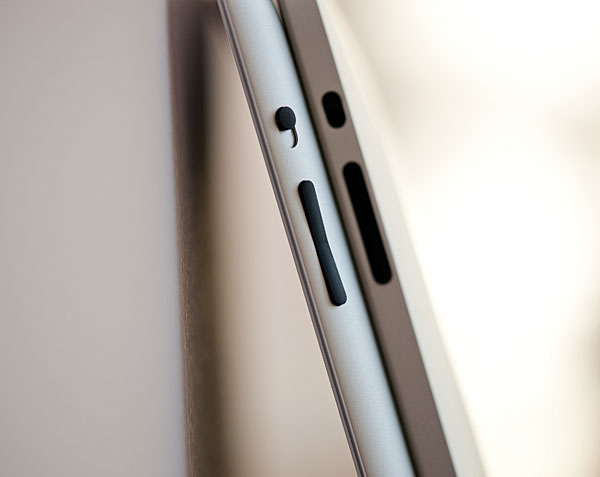
Apple iPad 2 (left), Apple iPad (right)
Along the right side are the mute/rotation switch and the volume rocker. The ends of the volume rocker protrude out further in the iPad 2 than they did with the original - yet another welcome change.
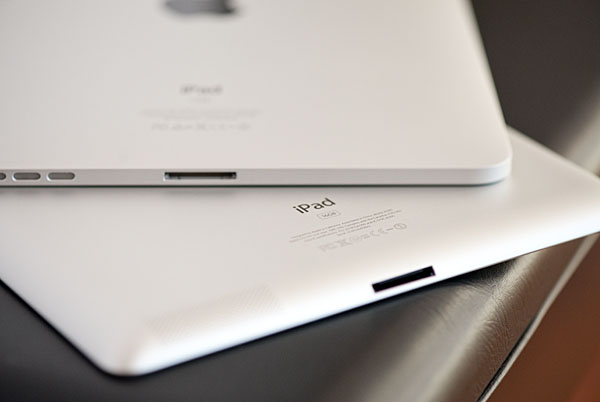
Apple iPad 2 (bottom), Apple iPad (top)
The dock connector is arguably the biggest flaw in the design. Because of the angled edges of the new iPad, the dock connector actually finds itself located in the middle of a slope. As a result inserting a standard dock cable is a bit awkward. On the original iPad you could just line up the cable with the middle of the bottom edge and sneak it in, on the iPad 2 there's more of a guessing game - usually involving me scraping the cable side dock connector against the aluminum back looking for the mate.
Just like last time the iPad 2 is available in both WiFi and 3G versions. The 3G versions add A-GPS support will the WiFi version can only pinpoint your location using WiFi trilateration. Apple offers separate AT&T and Verizon editions of the iPad 2, both of which have the same black antenna bar along the top of the back face of the tablet.
| Apple iPad 2 Pricing Comparison | |||||
| 16GB | 32GB | 64GB | |||
| WiFi | $499 | $599 | $699 | ||
| AT&T 3G | $629 | $729 | $829 | ||
| Verizon 3G | $629 | $729 | $829 | ||
NAND capacities haven't increased, nor have prices. We likely won't see an increase in storage capacity until 25nm NAND ships in greater volume. The iPad 3 will probably start at 32GB and go all the way up to 128GB as a result.
Regardless of carrier, the 3G models require a $130 premium over the WiFi only models. Personally I'd say that some sort of cellular data connectivity is really necessary to make the iPad 2 as useful as possible. Whether that comes from a 3G model or through a MiFi/smartphone hotspot doesn't really matter.
The pricing as a whole is still absurd. Even if you opt for the $499 WiFi version you'll be out another $39 for a case, plus another $39 if you want the HDMI adapter and then there are all of the apps you will likely start buying. This is an expensive platform to buy into and rest assured that there will be an even faster version out next year. Apple hasn't had much pricing pressure from the competition, however as we mentioned in our CES 2011 coverage - ASUS will be shipping a $399 Honeycomb tablet this year that should start to change that.


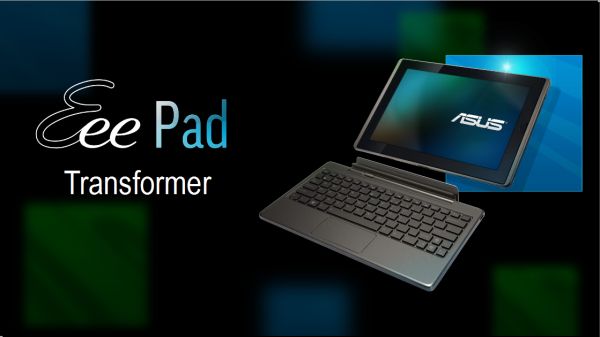








189 Comments
View All Comments
VivekGowri - Saturday, March 19, 2011 - link
I think it's $799, but I agree, it's too high. The equivalent iPad, at $729, is also way up there - really the only iPad that makes much sense as far as value goes is the base 16GB WiFi. I think the Xoom is probably going to have it's price cut by at least $100, if not $200, before it actually gets anywhere - ASUS took the right tack by putting it's lowest end Honeycomb tablet at $399.KoolAidMan1 - Saturday, March 19, 2011 - link
Where the iPad really works for me is as a travel device and in the living room. The iPad is just much nicer to use with in-flight wifi. Small, no cable management, and the battery will outlast a LAX-JFK roundtrip. My laptop lives in the overhead storage bin.You mentioned that the iPad has replaced the ThinkPad in airports, and I think that is spot-on. It is just so much more convenient and manageable to use compared to a laptop. I've left the laptop at home twice and I didn't miss it much, aside from not being able to play Starcraft 2 when I'm on the road. :)
The "sharing" aspect of the device has great advantages in a work environment, especially when you want to go over PDFs with a group of people. No need to crowd around or turn a laptop, just pass around the iPad.
As for the living room and bedroom, self explanatory. Not being tethered to the home office in order to fire off email is nice. Ditto using it as a universal remote in the living room.
It is a luxury device and a supplement, absolutely, but a damn good one.
nickdoc - Sunday, March 20, 2011 - link
Finally a sensible person. We are definitely on the same page.kevith - Sunday, March 20, 2011 - link
"You're absolutely right" almost always really means: "I totally agree..." :-)relentlessfocus - Saturday, March 19, 2011 - link
As always a real insight into the hardware. I'd like to make an observation about generalising from your own inability to find something that tablets add to your PC./smartphone mix to the larger sphere of buyers. Indeed most are not crazy and overly rich.My friends have a 2 year old child. I have no doubt that eventually she'll be reacting with laptops and desktops but my oh my how much my friends talk about the 3 of them with the iPad. Not an Anandtech thing... fine. A real life use. I think so.
Jake Humphrys is the lead for BBC's Formula 1 coverage here in the UK. While talking live in the pits with his co-commentators he now holds an iPad cupped in his hand that he gracefully reads from and then puts to his side as he gets live update info from his directors as the show is broadcast. OK, its not an Anandtech thing but its a real life use for a tablet that you wouldn't do with a netbook or notebook.
It's being used by coaching staff in sports and by doctors making their rounds in hospitals. It's used by major corporations for field workers running in house bespoke apps for catalogues and inventory and real time pricing etc. It's used by estate agents in the field with their clients and its used in trendy clothing shops like All Saints to display the entire store catalog for customers to browse. I could without a doubt put together 100 real life uses that "did figure out a use for it" distinctive from what you might do with a netbook or laptop or even desktop.
Your reviews set the gold standard in so many ways but in this one way its a shame you brought such a limited perspective to the usefulness of touch tablets in the world at large. I understand that people who do certain kinds of work really do find that a touch tablet device may not be useful, indeed you may not own a pickup truck or headphone amplifier. But the slant of your article and some of the comments above implies a great generality than I think can be justified.
Anand Lal Shimpi - Saturday, March 19, 2011 - link
First of all, thank you for your kind words - I really do appreciate them.I don't doubt that there are specific uses for a tablet that a notebook cannot do as well. I mentioned one of these in the review - simply passing around the iPad for others to look at, information sharing, it's a lot easier to do this than with a clunky notebook.
My point about the usefulness is that it's currently not powerful enough, flexible enough and ergonomic enough to completely replace a notebook. I'm not saying it won't get there, but I don't believe it's there today. The iPad 2 is a great device, but it's an augment to existing computing devices - and for some users that's tough to integrate into their existing workflow.
If you can find a fit that makes sense however, it's a great device.
Take care,
Anand
Azethoth - Sunday, March 20, 2011 - link
Good article. However I do not think the point of tablets and smartphones are to replace netbooks. I think their point is to compete on apps. If they can do something critical to someone better than another form factor then they win a sale. I think it will turn out there are more apps that are tablet appropriate than netbook appropriate.Unless there are more interface revolutions I just do not think there can be a 100% intersection between netbook and tablet utility. So while netbooks will remain better at the things a lot of people complain about not being able to do on a tablet, tablets will eat their lunch market share wise because of the many more things they do good enough or perfectly.
Fontanka - Sunday, March 20, 2011 - link
"Workflow ", "Use", "Users","Usefulness".........That's not what most of the 15 million purchasers (and counting) are thinking about....they want to communicate, be entertained and diverted when NOT WORKING. The iPad delivers.
Fontanka
WaltFrench - Sunday, March 20, 2011 - link
@Anand, let me second the kind words of @relentlessfocus.And also his point: a tablet and a notebook are largely incommensurable.
Lightweight, sub $1000 notebooks with 11-hour battery life, compressed learning times and near-instant app startup don't exist.
Likewise, notebooks don't have anywhere near the touchscreen's I/O capabilities, which you call out as great in iMovie and GarageBand. (I'd add the iOS app I use for writing Chinese as part of my studies, and the painting app used by high profile artists to create New Yorker covers.) Then, there's a new mix of software appropriate to mobile life, including the many “specialized” apps @relentlessfocus offered.
I get that, by definition, our current workflows can't be optimized on a tablet. (Mine, with multiple screens on the desktop, and a bigscreen laptop, would be horrible. Why would I even think to try?) These things are "technical disruptors," "creative destructors," "inventor's dilemmas," however you want to characterize them. They enable new usage modes at the same time that they're not as good, or downright awful, for the old ones. They serve new customers better than the old; this is all old hat ever since Shiva got incorporated into the pantheon.
But thanks for such a complete review, for those of us who happen to be dabbling in devices that enable new functions, new activities.
Anand Lal Shimpi - Sunday, March 20, 2011 - link
I believe we're actually in agreement here. The tablet is a disruptive form factor and a disruptive device. In the article I state that I believe there's a glorious future for tablets, however I believe we're still at an early point in the evolution. Since we're operating on a faster-than-moore'slaw-curve here, you're looking at a 12 month product cycle with these things. As such I believe a cautious approach to investment is better, especially given the price points we're talking about.By all means, if you have the money to spend and have a genuine use for it - the iPad 2 is a great device. I'm genuinely giving the iPad 2 another chance, I really wanted to use the iPad 1 I just found myself carrying it and a notebook wherever I went.
For example, I'm traveling now for CTIA but I brought the MacBook Air. I'd much prefer reading comments on the iPad 2, but I like responding to them on the Air. I don't really know what the right solution is to that problem. It can't be to have one device for reading web pages and another device for contributing to web sites? I believe there's still a lot of work to be done here, that's all I'm saying - not that the iPad or the tablet are doomed.
Take care,
Anand